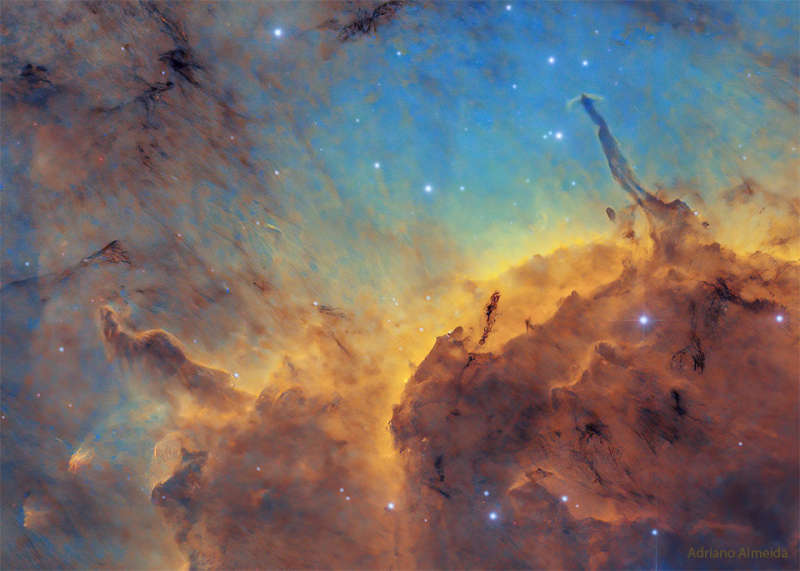
|
Credit & Copyright: Adriano Almeida
Explanation:
What dark structures arise within the Pelican Nebula?
On the whole, the nebula appears like a bird
(a pelican)
and is seen toward the constellation of a different bird:
Cygnus,
a Swan.
But inside, the Pelican Nebula is a place lit up by new stars and
befouled by dark dust.
Smoke-sized
dust grains start as
simple carbon compounds formed in the
cool atmospheres of young stars but are dispersed by
stellar winds and
explosions.
Two impressive Herbig-Haro jets are seen emitted by the star HH 555 on the right,
and these jets are helping to
destroy the
light year-long dust
pillar that contains it.
Other pillars and jets are also visible.
The featured image was
scientifically-colored
to emphasize light emitted by small amounts of
heavy elements in a nebula made predominantly of the light elements
hydrogen and
helium.
The Pelican Nebula (IC 5067 and IC 5070) is about 2,000
light-years away and can be found with a small telescope
to the northeast of the bright star
Deneb.
Explore Your Universe:
Random APOD Generator
|
January February March April May June July August September October November December |
| |||||||||||||||||||||||||||||||||||||||||||||||||||||||
NASA Web Site Statements, Warnings, and Disclaimers
NASA Official: Jay Norris. Specific rights apply.
A service of: LHEA at NASA / GSFC
& Michigan Tech. U.
Based on Astronomy Picture
Of the Day
Publications with keywords: jet - Pelican Nebula
Publications with words: jet - Pelican Nebula
See also:
- APOD: 2025 September 3 Á Cir X1: Jets in the Africa Nebula
- APOD: 2025 May 9 Á IXPE Explores a Black Hole Jet
- APOD: 2025 April 9 Á HH 49: Interstellar Jet from Webb
- APOD: 2024 October 1 Á Porphyrion: The Longest Known Black Hole Jets
- The Galaxy, the Jet, and a Famous Black Hole
- APOD: 2024 May 7 Á Black Hole Accreting with Jet
- APOD: 2023 September 19 Á HH 211: Jets from a Forming Star
